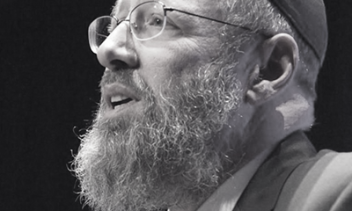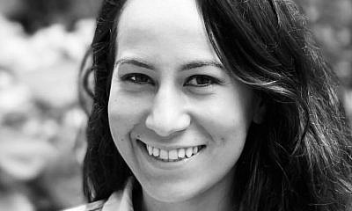The first memory I have of being conscious of being Jewish was on vacation with my family when I was about five or six. We were either in Florida or New Hampshire—I forget—but I realized that most people around me were not wearing yarmulkes. Up until that point, I was in school and camp with people who were visibly Jewish. For the first time, I felt different. I remember arguing with my sister over which one of us was more visibly Jewish—I could wear a baseball hat, while she was clearly wearing clothing that a “normal” girl would not wear in the summer. It was my first introduction to a world different from the one into which I was born.
As a kid, Jews were people who looked like me. My ever-sensitive mother began to expand my worldview. She explained that some of my cousins didn’t wear yarmulkes or practice Jewish law like I did, but they were still Jewish. She raised us with a sense of nuance—certainly for children—and an abiding sense of human dignity. We weren’t allowed to call people goyim. She admonished me in fifth grade for saying a joke where the punchline was about Arabs.
Differences always pique the curiosity of children—people who look different, talk different, walk different—but my mother instilled in me a basic sensitivity and decency, especially for people different from myself. For that, I am still grateful. But nuance and subtlety, regardless of even the best parents’ efforts, can undermine conviction and pride. It often feels easier to assert what makes you special and different, at the expense of others. And certainly, negotiating between my own personal Jewish convictions and commitments and those of other Jews around me has been both a personal mission and a struggle of sorts.
Connecting to the entirety of the Jewish people is different than, for instance, connecting to a company that employs you, or an institution with which you may be affiliated. Before every July Fourth weekend, my wife has a company wide conference call. They talk about dedication and devotion to “the firm” and asking yourself “what’s best for the firm.” It’s a running joke in our house. “Can you take out the garbage?” she’ll ask. “Well,” my reflexive response, “would it help the firm?” Of course, it’s a joke. Our affiliations with work life, however loyal, are utilitarian. We work in order to be paid. If you had another offer and it was attractive enough, you’d leave. The Jewish community is different. This is how Rabbi Soloveitchik explains it in his essay, “The Community,” (Tradition 17:2, 1978):
The community is not just an assembly of people who work together for their mutual benefit, but a metaphysical entity, an individuality; I might say, a living whole. In particular, Judaism has stressed the wholeness and the unity of Knesset Israel, the Jewish community. The latter is not a conglomerate. It is an autonomous entity endowed with a life of its own.
I’ve always found this conception deeply moving, but also tricky to navigate. It’s certainly heartening to connect to the larger conceptual body of Knesseth Yisroel, but it is also challenging. When you meet a Jew who annoys you, a Jew with whom you vehemently disagree, or a Jew with whom you share no similar interests—what do you see? What connects you then? Linking the Jew in front of you to the larger, almost ethereal, notion of Knesseth Yisroel is far easier to do in theory than in practice.
We need our proverbial mechitzahs because differences still endure, but sometimes you want to peer over the mechitzah, whisper ideas, and pass notes in the back of the classroom.
Social media has not made this any easier, but it certainly has made it harder to avoid. In May 2020, I wrote in Forward about the struggles and opportunities that social media presents in fostering some measure of Jewish unity. I contrasted the necessary boundaries of institutional Jewish life with the muddled and porous world of online engagement:
When institutions are the mediators of Jewish dialogue, the boundaries and rules must be clearer. Institutional Judaism thrives on clear agendas and behavioral consistency. In order to cater to communal constituencies, institutions create norms that rightfully require an element of individual sacrifice.
Of course, we need Jewish institutions. They centralize philanthropic support, build communal bonds, and formalize movements.
And yet, it’s just not all we need. Outside of our organizational walls, social media allows for conversations unfettered by the communal conventions that normally align us.
To paraphrase the classic The New Yorker cartoon, “On the internet, nobody knows your denomination.”
That does not mean that we’ve entered an era of post-denominational kumbaya agreement. Far from it. Important and crucial differences still exist, like how halakha is interpreted, what Shabbos looks like, and—don’t think I forgot—gender roles.
But the magic of discourse on #JTwitter, when it is at its best, is that conversations, arguments, and disagreements are for a moment allowed to transcend our familiar institutional camps. Torah ideas, jokes, and debates are judged on the merits. Likes and RT’s may not equal endorsement, but it’s hard to deny that they signal resonance.
And people are liking and RTing people they find interesting, thought-provoking, and funny, not just who they can daven with—which, by the way, is also OK. We need our proverbial mechitzahs because differences still endure, but sometimes you want to peer over the mechitzah, whisper ideas, and pass notes in the back of the classroom.
Neither Facebook nor Twitter are the antidotes or the poison that will address the fractured Jewish world we live in—they’ve just transformed the level of exposure we each have to that world.
Rav Shlomo Freifeld, the famed educator and founder of Shor Yashuv yeshiva, would frequently discuss what it means to be a “big person.” Big people contain a lot. There is room in their hearts and minds for all of the contradictions and changes needed to connect with and reach diverse and often contradicting groups of people. Much like Walt Whitman’s quip: “Do I contradict myself? Very well, then I contradict myself, I am large, I contain multitudes.” I am not a big person, but I strive to become one.
In my book, Sin·a·gogue: Sin and Failure in Jewish Thought, I discuss what I think is the Talmudic secret to cultivating the capacity to contain the multitudes within Knesseth Yisroel:
Tractate Yoma (39b) retells the story of the death of Shimon Ha-Tzadik, one of the most celebrated High Priests in Jewish history. In the last year of his life Shimon Ha-Tzadik gathered all his students and told them he was going to die. How did he know? He explained to them that each year on the holiest day of the year, Yom Kippur, in the holiest place in the world, the Holy of Holies, he had a vision. When Shimon was alone inside the Holy of Holies, he met an old man who was dressed in white and wrapped in all white garments. This man would enter with Shimon and exit with him. This year, however, he saw someone else. Shimon saw a man dressed all in black. The man entered with Shimon but did not exit with him. And as Shimon predicted, he died a few weeks after Yom Kippur. Of course, the glaring question is who was the man he envisioned appearing in the Holy of Holies? I once heard a moving suggestion that encapsulates much of our discussion of leaders—both successful and failed. The man whom Shimon saw was the Saba Kaddisha [סבא קדישא] of the Jewish people—the manifestation of how Shimon Ha-Tzadik viewed the Jewish people. As long as Shimon’s vision was of the congregation dressed in white—optimistic, ambitious, and open to opportunity—he knew he still had a future as a leader of these people. However, once his representation of the Jewish people was dressed in all black—pessimistic, cynical, and negative—he knew his time as a leader was expiring.
It’s easy to throw your hands up and retreat away from the fractured reality that the conceptual ideal of Knesseth Yisroel has become. But that’s seeing the Jewish people in black clothes of mourning. I try to see Knesseth Yisroel dressed in white.
These are the conversations we will be having this month leading into the Jewish New Year—Rosh Hashanah 5781. How to cultivate a deeper connection and appreciation for the Jewish people—even when they disappoint. How to stay grounded in your conviction even when bombarded with the pluralities of opinions and representation of Jewish life. And ultimately, how to develop a capacity to contain multitudes. To see our future and our people as dressed in white.








